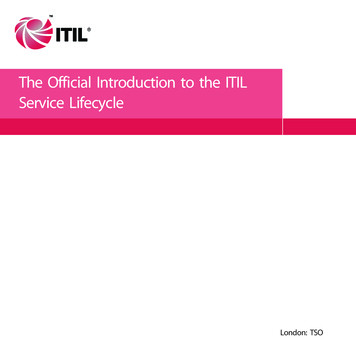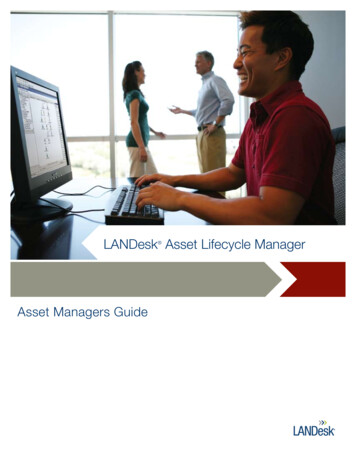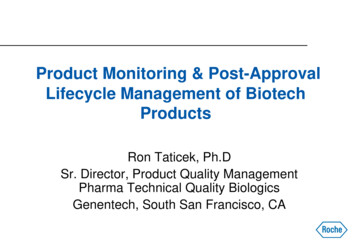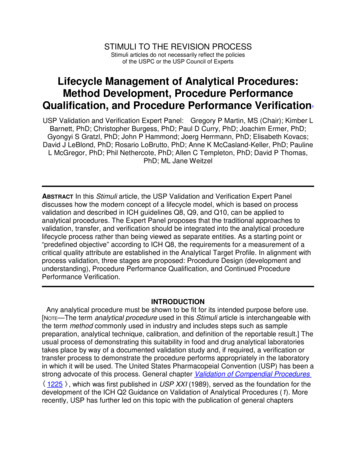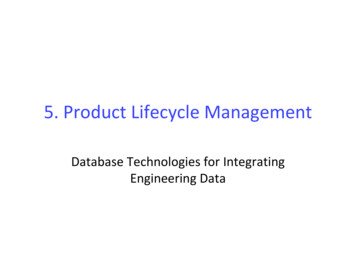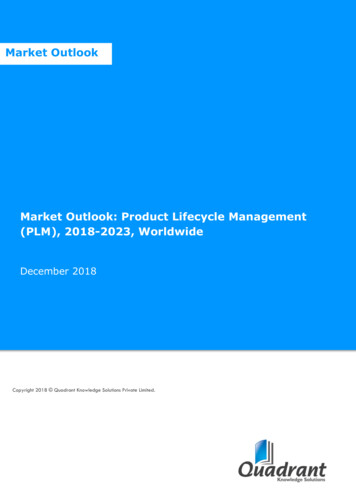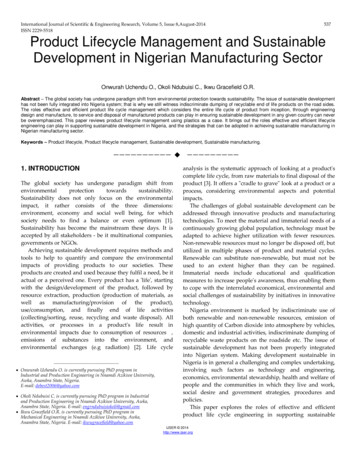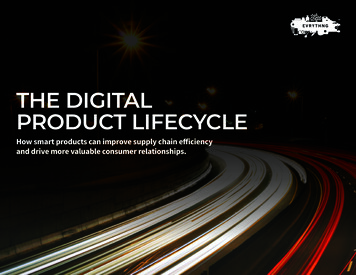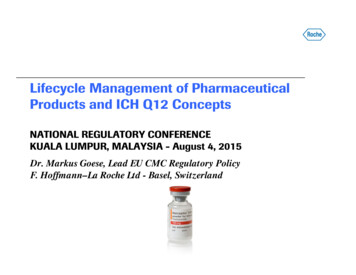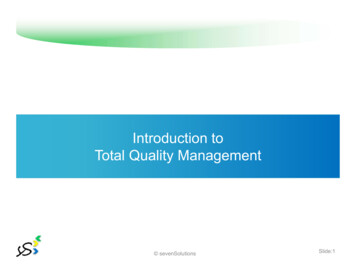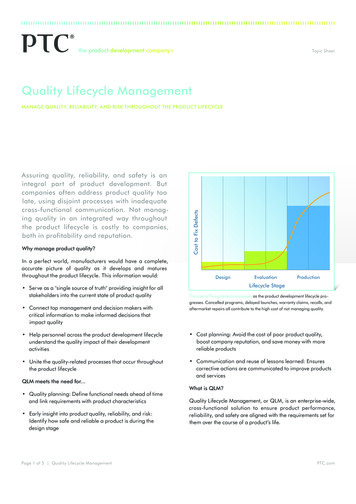
Transcription
Topic SheetQuality Lifecycle ManagementAssuring quality, reliability, and safety is anintegral part of product development. Butcompanies often address product quality toolate, using disjoint processes with inadequatecross-functional communication. Not managing quality in an integrated way throughoutthe product lifecycle is costly to companies,both in profitability and reputation.Why manage product quality?In a perfect world, manufacturers would have a complete,accurate picture of quality as it develops and maturesthroughout the product lifecycle. This information would: Serve as a "single source of truth" providing insight for allstakeholders into the current state of product quality Connect top management and decision makers withcritical information to make informed decisions thatimpact qualityCost to Fix DefectsMANAGE QUALITY, RELIABILITY, AND RISK THROUGHOUT THE PRODUCT LIFECYCLEDesignEvaluationProductionLifecycle StageThe cost of fixing defects increases as the product development lifecycle progresses. Cancelled programs, delayed launches, warranty claims, recalls, andaftermarket repairs all contribute to the high cost of not managing quality. Help personnel across the product development lifecycleunderstand the quality impact of their developmentactivities Cost planning: Avoid the cost of poor product quality,boost company reputation, and save money with morereliable products Unite the quality-related processes that occur throughoutthe product lifecycle Communication and reuse of lessons learned: Ensurescorrective actions are communicated to improve productsand servicesQLM meets the need for. Quality planning: Define functional needs ahead of timeand link requirements with product characteristics Early insight into product quality, reliability, and risk:Identify how safe and reliable a product is during thedesign stagePage 1 of 5 Quality Lifecycle ManagementWhat is QLM?Quality Lifecycle Management, or QLM, is an enterprise-wide,cross-functional solution to ensure product performance,reliability, and safety are aligned with the requirements set forthem over the course of a product’s life.PTC.com
Topic SheetQLM is used to. Build quality, reliability, and risk planning into the entirelifecycle Complete management visibility into key dimensions ofproduct safety and reliability at any lifecycle stage Align functional needs to product requirements Cross-functional collaboration across multipledepartments and teams responsible for product quality,safety, and reliability Ensure requirements are met by specific productcharacteristics Functional links between product requirements, productcharacteristics, and quality activities at each lifecycle stage Track characteristics systematically throughout the lifecycle A fully documented history of product development from aquality perspective Identify quality issues and initiate corrective actions Communicate and reuse corrective actions to irementsInnovateDesignImprove nextgeneration productsand systemsEvaluate systemreliability and riskQualityLifecycleManagementServiceTestManage repair,maintenance, andcorrective actionsLink test plan/resultsto product requirements and designManufactureImplement andmonitor qualitycontrolsQuality Lifecycle Management, or QLM, unites the quality-related activities ofeach stage in the product lifecycle through a single database platform.Benefits of QLMQLM links together each of the quality, reliability, and safetyactivities that take place across every stage of the productdevelopment lifecycle. Through QLM, one lifecycle stageinforms the next, and feedback from each stage is automatically fed into other relevant stages, creating a unified,holistic model of overall product quality.With numerous quality, reliability, and safety processes unitedinto a single software platform, QLM enables: A highly structured solution automating the workflowof quality information and feedback between productlifecycle stagesPage 2 of 5 Quality Lifecycle ManagementQLM at each product lifecycle stageQLM enables the integration of all lifecycle processes usedto ensure product quality, including: Planning: QLM begins with a quality plan in whichproduct requirements for performance, reliability, andsafety are clearly defined. Other elements of the productdevelopment lifecycle are accountable to the standards setin the quality plan. Design/Development: During system design, specializedrisk and reliability analyses are used to predict systemperformance and eliminate or mitigate risks. This is donebefore the more expensive phases of prototyping andmanufacture have begun. Testing: When optimal system design has been achieved,a comprehensive test plan is created using both theoutputs from reliability analysis and the predefinedproduct requirements to optimize testing activities.Prototype testing verifies and validates system design andearly reliability and risk analyses. Manufacture: After the design has been validated throughtesting, critical-to-quality work instructions are generatedto define and implement manufacturing control measuresthat ensure product quality is protected throughout themanufacturing stage. Service/Use: Service planning identifies the bestmethods to sustain product quality throughout fieldeduse, enabling the optimization of cost drivers such aspreventive maintenance schedules, spares, and prioritizedtroubleshooting guides. The service and use phasesproduce valuable feedback from product failures andother incidents that arise. These are reported for theinitiation of root cause analysis and corrective actionsessential to product improvement in current and nextgeneration designs.PTC.com
Topic Sheet Innovate: Product failure and performance data iscollected from the fielded use of products, and combinedwith lessons learned throughout all phases of productdevelopment, creating a common database of bestpractices. This database drives innovation by providinga single source of truth through which further productdevelopment activities are filtered during next-generationproduct design.Tools of QLMSystem ModelingWindchill PredictionReliability Prediction begins as design engineers create orimport a bill-of-material (BOM) and use software to calculatethe expected reliability of the parts, subsystems, and assemblies that make up the BOM. Quality Governance: Quality governance is the process ofestablishing and documenting process quality guidelinesand standards. It also requires the management andauditing of these standards, to ensure they are beingimplemented correctly throughout the organization.Because product quality is closely linked to process quality,many companies seek not only to identify and correctproduct nonconformances stemming from internal andexternal sources, but also to establish processes that track,monitor, audit, and manage these internal and externalnonconformances and the corrective actions used toaddress them.Windchill OpSimWindchill OpSim combines intuitive reliability block diagramming with optimization and simulation technology,enabling design engineers to create sophisticated productand system models, as well as to calculate key system metricssuch as availability, reliability, and maintenance and gin new porting /DashboardsPlanEvolve product fornext generationFunctional RequirementsCTQ CharacteristicsDesignChangeManagementConcept DevelopmentClosed-loopIntegrationIncorporate IdentifiedChangesStore, CommunicateFeedback to OtherLifecycle StagesSystem DesignDVP–DesignVerification PlanControl PlansManufactureTestRequirements VerificationIntegrateEngineering,ProductionTest Management, ExecutionValidate DesignConformanceDesign Validation, TrackingTest ResultsNonconformancesDetailed DesignMaintenance Policiesand Spares PlanningServiceSupport LogisticsServiceabilityFailure Reporting /ComplaintsPerformance Analysis & FeedbackFailure Capture, Analysis-Root Cause AnalysisCAPA (Corrective Action /Preventive Action)QLM is a closed loop solution to ensure that quality, reliability, and risk planning influence every stage of theproduct development lifecycle; information flows freely from one stage to the next; and corrective actions arecaptured and reused to improve next-generation products.Page 3 of 5 Quality Lifecycle ManagementPTC.com
Topic SheetReliability and Risk AnalysisClosed Loop Corrective Action SystemWindchill FMEA (Failure Mode and Effects Analysis)Windchill FRACAS (Failure Reporting, Analysis, andCorrective Action System)A FMEA is a bottom-up analysis technique that identifieseach failure mode beginning with the lowest-level components in the system, and examines the effects of their failureson higher levels of the system.The types of FMEAs used in QLM and their outputs are asfollows: A Functional or System FMEA focuses on the functions orrequirements that a product is designed to fulfill. It is usedearly on, in the design stage of products and systems. A Design or Component FMEA, also known as a piecepart FMEA, is focused on part risk and reliability. Itidentifies the component parts, subassemblies, andassemblies to consider the ways in which they can failand the effects that each of these failures can have onproduct operation. A Design FMEA can map to functionalrequirements indicated in the Functional or System FMEA,making it a powerful tool in an overall QLM solution. A Process FMEA or PFMEA examines the ways in whichmanufacturing can affect device operation and productquality. A Design Verification Plan, or DVP, is a test plan which maybe output from a Functional FMEA or a Design FMEA. ADVP is used to validate the requirements of a system, and islinked to the design requirements specified in the FMEA toshow whether or not that requirement has been met. A Control Plan is most commonly output by the ProcessFMEA. Control Plans are used to specify and implementcontrols that will prevent or mitigate the risks to productquality that may arise during manufacturing, as identifiedby the Process FMEA. The Control Plan communicatesfeedback to design and testing.Windchill FTAWindchill FTA (Fault Tree Analysis) quantifies system riskand reliability to enable targeted decisions about design,maintenance, and controls in order to reduce the likelihoodof system failure. Fault Tree analysis is used to construct agraphical representation of a product’s critical safety/failureissues and identify their possible causes and contributingfactors.Page 4 of 5 Quality Lifecycle ManagementWhen errors occur during testing or fielded use, WindchillFRACAS captures failure data and facilitates the implementation of closed loop corrective action processes. WindchillFRACAS is used in QLM as early as the testing phase of theproduct lifecycle and throughout service and use.Quality GovernanceWindchill NonconformanceWindchill Nonconformance facilitates the managementof all activities associated with nonconformance handlingin a regulated environment. Leveraging valuable internalinformation related to quality – including test results, manufacturing inspections, and supplier lots – Windchill Nonconformance enables initiation, evaluation, assignment,monitoring, and review of each nonconformance to ensureit is addressed in a closed-loop manner.Windchill Customer ComplaintsWindchill Customer Complaints provides for the intake,evaluation, and investigation of customer feedback for fielded products in a regulated environment. With the ability togenerate and electronically submit regulatory reports for themedical device field, and seamless integration with WindchillCAPA, Windchill Customer Complaints ensures that everyrecorded item is addressed with closed-loop functionalitythat is highly structured, automated, and repeatable.Windchill CAPAWindchill CAPA (Corrective Action / Preventive Action) enablesa closed loop corrective action workflow to address the rootcause analysis, corrective or preventive action identification,and resolution of product or process quality issues identifiedfrom internal or external sources. In addition to providing forthe role-based workflow and management review of CAPAs,Windchill CAPA enables the monitoring, tracking, review,and audit of system-wide CAPAs, providing a single view intothe safety, manufacturing, and performance trends coveringthe lifespan of a product.PTC.com
Topic SheetCharacteristics of a successful QLM solutionFor more informationA successful QLM solution requires the seamless integrationof analysis methodologies to enable cross-functional qualityactivities, enterprise-level accessibility to support personnelcollaboration, and structured workflow tools to implementclosed loop quality processes: all of which are realized inthe Windchill Quality Solutions software suite.For more information on Windchill Quality Solutions, pleasevisit: PTC.com/products/windchill/qualityIntegration Windchill Quality Solutions encompass a single softwareplatform facilitating a full range of quality-relatedactivities and analyses 2011, Parametric Technology Corporation (PTC). All rights reserved. Information describedherein is furnished for informational use only, is subject to change without notice, and shouldnot be construed as a guarantee, commitment, condition or offer by PTC. PTC, the PTC Logo,Windchill, and all PTC product names and logos are trademarks or registered trademarks ofPTC and/or its subsidiaries in the United States and in other countries. All other product orcompany names are property of their respective owners. The timing of any product release,including any features or functionality, is subject to change at PTC’s -0411 Windchill Quality Solutions enable the easy, automaticoutput of data from one analysis type to the next Windchill Quality Solutions implement functional linksbetween key quality-related lifecycle activitiesAccessibility Windchill Quality Solutions provide enterprise-wideaccess via a web-based platform for all quality-relatedpersonnel, regardless of location Windchill Quality Solutions support the efficientreporting of high-level quality information for use by topmanagement personnelStructure Windchill Quality Solutions facilitate a standardizedmethodology to capture quality issues found during anystage in product development Windchill Quality Solutions offer highly structuredworkflow tools to ensure the communication of qualityissues to responsible personnel Windchill Quality Solutions supply built-in tools toautomate the reuse of lessons learned captured in anyproduct lifecycle stagePage 5 of 5 Quality Lifecycle ManagementPTC.com
QLM at each product lifecycle stage QLM enables the integration of all lifecycle processes used to ensure product quality, including: Planning: QLM begins with a quality plan in which product re
